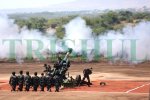A bit old, but a good write up by Saurav Jha.
With Dhanush howitzer, Artillery Corps lends a major combat arm to Indian Army at LoC
Dhanush howitzer makes outranged Pakistani artillery units more vulnerable to Indian counter-battery fire, something India has wanted since the Kargil War.
By Saurav Jha
26 March, 2019 4:13 pm
File picture of the Dhanush gun | Source: Ministry of Defence
Since the 1999 Kargil War, the Indian Army’s Artillery Corps has been working towards becoming a ‘major combat arm’, instead of being a mere ‘support arm’ for infantry or armour.
While recent imports such as the K-9 Vajra-T Self-Propelled Howitzer(SPH) and the M-777 Ultra Light Weight howitzer(ULH) have been in the spotlight, it is the indigenous 155 mm/45 calibre Dhanush howitzer — scheduled to be formally inducted on March 26 — that will provide the Indian Army with an advantage, especially along the mountainous terrain of the Line of Control (the LoC).
Although derived from the baseline FH-77B, the Ordnance Factory Board’s (OFB’s) Dhanush is a major step-up in terms of capability over the former.
Moreover, with a high-level of indigenous content (IC), the Dhanush howitzer will be much easier to maintain than the 155 mm/39 caliber Bofors FH-77B howitzer currently deployed by the Indian Army at the LoC. In fact, Dhanush’s production will make indigenous spares available for improving the serviceability of the FH-77B as well.
Higher range, better accuracy
For instance, the longer barrel length of the Dhanush, along with the use of a ‘Zone-6’ bi-modular charge system, allows it to fire an extended range full-bore base bleed (ERFB-BB) shell to a maximum range of 38.4 kilometres (km) as opposed to just 24 km for the FH-77B. As such, the Dhanush out ranges the FH-77B by 9 km or more for all standard shell types and the M-777 by 6-8 km, if a similar comparison were to be made. Importantly, it also out ranges any towed gun or howitzer in the Pakistan Army’s arsenal by a significant margin.
The Dhanush howitzer also has superior fire control and accuracy when compared to the FH-77B due to the incorporation of an automatic gun alignment and positioning system (AGAPS), which uses an enhanced tactical computer (ETC) for on-board ballistic computations, a muzzle velocity radar and an inertial navigation system (INS)-based sighting system capable of receiving GPS updates.
In the case of the FH-77B, ballistic computations and muzzle velocity recordings are done ‘off-board’ at the battery command post level. Each Dhanush unit is also provided with a STAR-V radio, which along with the ETC and a gun display unit make it compatible with the Indian Army’s Shakti Artillery Combat Command & Control System (ACCCS) that automates artillery operations in a network-centric environment.
The use of AGAPS along with electro-hydraulics suited for auto gun laying enables the Dhanush to be aimed at a target much faster than the FH-77B, once targeting data is available. This means that the Dhanush can better utilise enemy gun location data provided by the Swathi Weapon Locating Radar (WLR) and drones used by search and target acquisition (SATA) units of the Artillery Corps.
Indeed, the Dhanush makes outranged Pakistani artillery units more vulnerable to Indian counter-battery fire, while itself staying out of reach. Dhanush’s longer range and high rate of fire will also make it useful in defeating localised Pakistan Army’s offensives in sectors of the LoC where the terrain favours the Pakistani side.
Flexibility allows surrounding the target
The longer range, superior accuracy and autonomous features of the Dhanush provide the Artillery Corps with the necessary flexibility in terms of deployment and siting of howitzers in the mountains. The destruction of heavily fortified Pakistani posts along the LoC requires interlocking artillery fire from different directions.
This is more easily accomplished if a standard artillery regiment consisting of 18 guns can be disaggregated and divided into groups (‘firing units’ in artillery parlance) tailored to reducing a ‘registered’ target.
For example, out of the 18 guns in a regiment, two could be sited closer to a target in different locations and used in what is called a ‘direct-in-direct fire’ (DIDF) mode, a concept that emerged during the Kargil War and was found to be rather efficacious.
Meanwhile, the remaining guns — themselves sub-divided into firing units and kept further back — could engage the target from different directions, thereby maximising the probability of destroying the target. The Dhanush seems particularly suited for employment in DIDF mode, since it also has an advanced day and night direct firing system.
Leaving aside the Vajra-T, which in any case is a tracked self-propelled howitzer meant to support Indian Army’s Strike Corps in the plains, the Dhanush has a mobility advantage over the M-777 in a deployment area since it has a self-propulsion unit that the M-777 lacks. And though the M-777 has greater strategic mobility since it can be helo-lifted, it is the Dhanush that is more suited for heavy hitting across the LoC. What is more, the Dhanush has been far more extensively tested than the M-777 in Indian conditions, both in terms of mobility and firepower.
At the moment, 114 Dhanush units are on order with 18 expected to be delivered before the end of 2019. A requirement for a further 300 units of this type is being projected by the Indian Army with annual production expected to reach 60 units in a couple of years. Once inducted in sizeable numbers, the Dhanush will unequivocally add to the deterrent power of the Indian Army along the LoC.
The author is a former consultant to FICCI’s International Division and Chief Editor of Delhi Defence Review. His Twitter handle is @SJha1618
With Dhanush howitzer, Artillery Corps lends a major combat arm to Indian Army at LoC


































